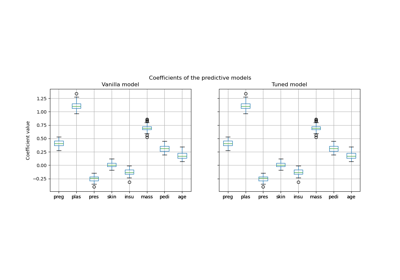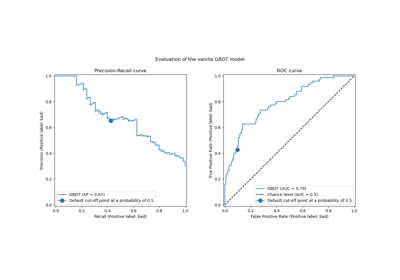sklearn.model_selection.TunedThresholdClassifierCV¶
- class sklearn.model_selection.TunedThresholdClassifierCV(estimator, *, scoring='balanced_accuracy', response_method='auto', thresholds=100, cv=None, refit=True, n_jobs=None, random_state=None, store_cv_results=False)[source]¶
Classifier that post-tunes the decision threshold using cross-validation.
This estimator post-tunes the decision threshold (cut-off point) that is used for converting posterior probability estimates (i.e. output of
predict_proba) or decision scores (i.e. output ofdecision_function) into a class label. The tuning is done by optimizing a binary metric, potentially constrained by a another metric.Read more in the User Guide.
Added in version 1.5.
- Parameters:
- estimatorestimator instance
The classifier, fitted or not, for which we want to optimize the decision threshold used during
predict.- scoringstr or callable, default=”balanced_accuracy”
The objective metric to be optimized. Can be one of:
a string associated to a scoring function for binary classification (see model evaluation documentation);
a scorer callable object created with
make_scorer;
- response_method{“auto”, “decision_function”, “predict_proba”}, default=”auto”
Methods by the classifier
estimatorcorresponding to the decision function for which we want to find a threshold. It can be:if
"auto", it will try to invoke, for each classifier,"predict_proba"or"decision_function"in that order.otherwise, one of
"predict_proba"or"decision_function". If the method is not implemented by the classifier, it will raise an error.
- thresholdsint or array-like, default=100
The number of decision threshold to use when discretizing the output of the classifier
method. Pass an array-like to manually specify the thresholds to use.- cvint, float, cross-validation generator, iterable or “prefit”, default=None
Determines the cross-validation splitting strategy to train classifier. Possible inputs for cv are:
None, to use the default 5-fold stratified K-fold cross validation;An integer number, to specify the number of folds in a stratified k-fold;
A float number, to specify a single shuffle split. The floating number should be in (0, 1) and represent the size of the validation set;
An object to be used as a cross-validation generator;
An iterable yielding train, test splits;
"prefit", to bypass the cross-validation.
Refer User Guide for the various cross-validation strategies that can be used here.
Warning
Using
cv="prefit"and passing the same dataset for fittingestimatorand tuning the cut-off point is subject to undesired overfitting. You can refer to Consideration regarding model refitting and cross-validation for an example.This option should only be used when the set used to fit
estimatoris different from the one used to tune the cut-off point (by callingTunedThresholdClassifierCV.fit).- refitbool, default=True
Whether or not to refit the classifier on the entire training set once the decision threshold has been found. Note that forcing
refit=Falseon cross-validation having more than a single split will raise an error. Similarly,refit=Truein conjunction withcv="prefit"will raise an error.- n_jobsint, default=None
The number of jobs to run in parallel. When
cvrepresents a cross-validation strategy, the fitting and scoring on each data split is done in parallel.Nonemeans 1 unless in ajoblib.parallel_backendcontext.-1means using all processors. See Glossary for more details.- random_stateint, RandomState instance or None, default=None
Controls the randomness of cross-validation when
cvis a float. See Glossary.- store_cv_resultsbool, default=False
Whether to store all scores and thresholds computed during the cross-validation process.
- Attributes:
- estimator_estimator instance
The fitted classifier used when predicting.
- best_threshold_float
The new decision threshold.
- best_score_float or None
The optimal score of the objective metric, evaluated at
best_threshold_.- cv_results_dict or None
A dictionary containing the scores and thresholds computed during the cross-validation process. Only exist if
store_cv_results=True. The keys are"thresholds"and"scores".classes_ndarray of shape (n_classes,)Classes labels.
- n_features_in_int
Number of features seen during fit. Only defined if the underlying estimator exposes such an attribute when fit.
- feature_names_in_ndarray of shape (
n_features_in_,) Names of features seen during fit. Only defined if the underlying estimator exposes such an attribute when fit.
See also
sklearn.model_selection.FixedThresholdClassifierClassifier that uses a constant threshold.
sklearn.calibration.CalibratedClassifierCVEstimator that calibrates probabilities.
Examples
>>> from sklearn.datasets import make_classification >>> from sklearn.ensemble import RandomForestClassifier >>> from sklearn.metrics import classification_report >>> from sklearn.model_selection import TunedThresholdClassifierCV, train_test_split >>> X, y = make_classification( ... n_samples=1_000, weights=[0.9, 0.1], class_sep=0.8, random_state=42 ... ) >>> X_train, X_test, y_train, y_test = train_test_split( ... X, y, stratify=y, random_state=42 ... ) >>> classifier = RandomForestClassifier(random_state=0).fit(X_train, y_train) >>> print(classification_report(y_test, classifier.predict(X_test))) precision recall f1-score support 0 0.94 0.99 0.96 224 1 0.80 0.46 0.59 26 accuracy 0.93 250 macro avg 0.87 0.72 0.77 250 weighted avg 0.93 0.93 0.92 250 >>> classifier_tuned = TunedThresholdClassifierCV( ... classifier, scoring="balanced_accuracy" ... ).fit(X_train, y_train) >>> print( ... f"Cut-off point found at {classifier_tuned.best_threshold_:.3f}" ... ) Cut-off point found at 0.342 >>> print(classification_report(y_test, classifier_tuned.predict(X_test))) precision recall f1-score support 0 0.96 0.95 0.96 224 1 0.61 0.65 0.63 26 accuracy 0.92 250 macro avg 0.78 0.80 0.79 250 weighted avg 0.92 0.92 0.92 250
Methods
Decision function for samples in
Xusing the fitted estimator.fit(X, y, **params)Fit the classifier.
Get metadata routing of this object.
get_params([deep])Get parameters for this estimator.
predict(X)Predict the target of new samples.
Predict logarithm class probabilities for
Xusing the fitted estimator.Predict class probabilities for
Xusing the fitted estimator.score(X, y[, sample_weight])Return the mean accuracy on the given test data and labels.
set_params(**params)Set the parameters of this estimator.
set_score_request(*[, sample_weight])Request metadata passed to the
scoremethod.- property classes_¶
Classes labels.
- decision_function(X)[source]¶
Decision function for samples in
Xusing the fitted estimator.- Parameters:
- X{array-like, sparse matrix} of shape (n_samples, n_features)
Training vectors, where
n_samplesis the number of samples andn_featuresis the number of features.
- Returns:
- decisionsndarray of shape (n_samples,)
The decision function computed the fitted estimator.
- fit(X, y, **params)[source]¶
Fit the classifier.
- Parameters:
- X{array-like, sparse matrix} of shape (n_samples, n_features)
Training data.
- yarray-like of shape (n_samples,)
Target values.
- **paramsdict
Parameters to pass to the
fitmethod of the underlying classifier.
- Returns:
- selfobject
Returns an instance of self.
- get_metadata_routing()[source]¶
Get metadata routing of this object.
Please check User Guide on how the routing mechanism works.
- Returns:
- routingMetadataRouter
A
MetadataRouterencapsulating routing information.
- get_params(deep=True)[source]¶
Get parameters for this estimator.
- Parameters:
- deepbool, default=True
If True, will return the parameters for this estimator and contained subobjects that are estimators.
- Returns:
- paramsdict
Parameter names mapped to their values.
- predict(X)[source]¶
Predict the target of new samples.
- Parameters:
- X{array-like, sparse matrix} of shape (n_samples, n_features)
The samples, as accepted by
estimator.predict.
- Returns:
- class_labelsndarray of shape (n_samples,)
The predicted class.
- predict_log_proba(X)[source]¶
Predict logarithm class probabilities for
Xusing the fitted estimator.- Parameters:
- X{array-like, sparse matrix} of shape (n_samples, n_features)
Training vectors, where
n_samplesis the number of samples andn_featuresis the number of features.
- Returns:
- log_probabilitiesndarray of shape (n_samples, n_classes)
The logarithm class probabilities of the input samples.
- predict_proba(X)[source]¶
Predict class probabilities for
Xusing the fitted estimator.- Parameters:
- X{array-like, sparse matrix} of shape (n_samples, n_features)
Training vectors, where
n_samplesis the number of samples andn_featuresis the number of features.
- Returns:
- probabilitiesndarray of shape (n_samples, n_classes)
The class probabilities of the input samples.
- score(X, y, sample_weight=None)[source]¶
Return the mean accuracy on the given test data and labels.
In multi-label classification, this is the subset accuracy which is a harsh metric since you require for each sample that each label set be correctly predicted.
- Parameters:
- Xarray-like of shape (n_samples, n_features)
Test samples.
- yarray-like of shape (n_samples,) or (n_samples, n_outputs)
True labels for
X.- sample_weightarray-like of shape (n_samples,), default=None
Sample weights.
- Returns:
- scorefloat
Mean accuracy of
self.predict(X)w.r.t.y.
- set_params(**params)[source]¶
Set the parameters of this estimator.
The method works on simple estimators as well as on nested objects (such as
Pipeline). The latter have parameters of the form<component>__<parameter>so that it’s possible to update each component of a nested object.- Parameters:
- **paramsdict
Estimator parameters.
- Returns:
- selfestimator instance
Estimator instance.
- set_score_request(*, sample_weight: bool | None | str = '$UNCHANGED$') TunedThresholdClassifierCV[source]¶
Request metadata passed to the
scoremethod.Note that this method is only relevant if
enable_metadata_routing=True(seesklearn.set_config). Please see User Guide on how the routing mechanism works.The options for each parameter are:
True: metadata is requested, and passed toscoreif provided. The request is ignored if metadata is not provided.False: metadata is not requested and the meta-estimator will not pass it toscore.None: metadata is not requested, and the meta-estimator will raise an error if the user provides it.str: metadata should be passed to the meta-estimator with this given alias instead of the original name.
The default (
sklearn.utils.metadata_routing.UNCHANGED) retains the existing request. This allows you to change the request for some parameters and not others.Added in version 1.3.
Note
This method is only relevant if this estimator is used as a sub-estimator of a meta-estimator, e.g. used inside a
Pipeline. Otherwise it has no effect.- Parameters:
- sample_weightstr, True, False, or None, default=sklearn.utils.metadata_routing.UNCHANGED
Metadata routing for
sample_weightparameter inscore.
- Returns:
- selfobject
The updated object.
Examples using sklearn.model_selection.TunedThresholdClassifierCV¶

Post-hoc tuning the cut-off point of decision function

Post-tuning the decision threshold for cost-sensitive learning